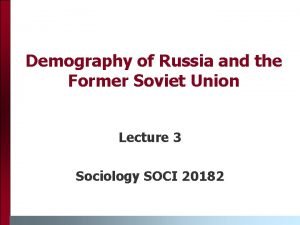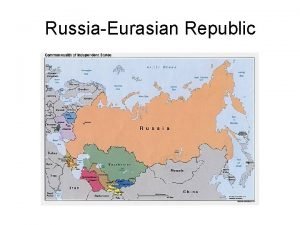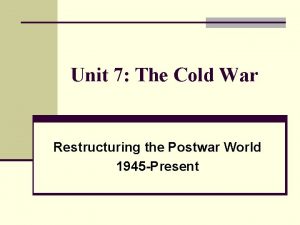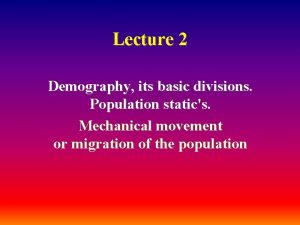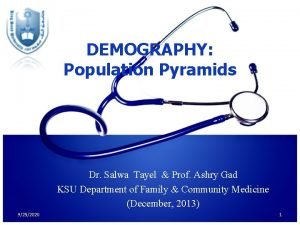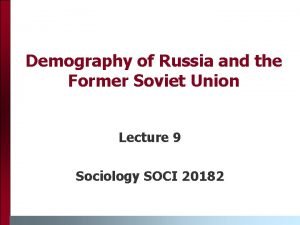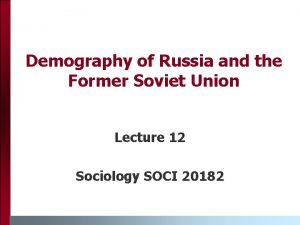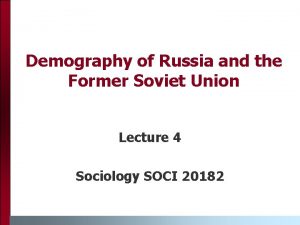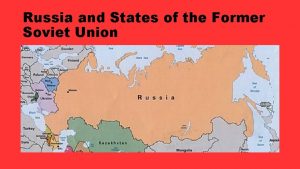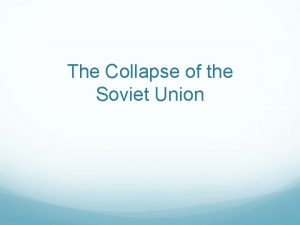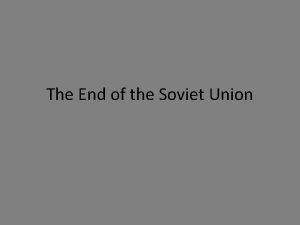Demography of Russia and the Former Soviet Union



























































- Slides: 59

Demography of Russia and the Former Soviet Union Lecture 5 Sociology SOCI 20182

Fertility measures and patterns

Fertility measures 1. 2. 3. 4. 5. 6. 7. 8. Crude Birth Rate, CBR General Fertility Rate, GFR Age-specific Fertility Rates, ASFR or Age-specific Birth Rates, ASBR Marital Fertility Rate, MFR Total Fertility Rate, TFR (period and cohort) Gross Reproduction Rate, GRR Net Reproduction Rate, NRR Parity Progression Ratios, PPR

Crude Birth Rate, CBR n n Number of births in the studied year divided by average size of the population during the year, per 1, 000 persons: CBR = Births / Total Population on July 1, x 1, 000 to get per 1, 000 persons

Crude Birth Rate, Pros and Cons n 1. 2. Pros: Easy to calculate Useful for calculation of the Rate of Natural Increase, RNI: RNI = CBR (crude birth rate) - CDR (crude death rate) and the Population Growth Rate, PGR: PGR = RNI (rate of natural increase) + NMR (net migration rate) n Cons: Depends not only on individual-level childbearing behavior, but also on age and sex distribution of population.

Crude Birth Rate, Cons n In old societies (with many retirement communities), and counties with male excess (e. g. with military bases), Crude Birth Rate may be exceptionally low, even if young women there have a lot of children Figure. CBR dynamics in Russia depends on population structure

General Fertility Rate, GFR n Number of births in the studied year divided by average size of the WOMEN of CHILDBEARING AGE (15 - 49 years ) during the year, per 1, 000 persons: n GFR = Births / Midyear female population, aged 15 -49 years, x 1, 000 to get per 1, 000 women

General Fertility Rate, Pros and Cons Pros: Characterizes fertility of women better than CBR (crude birth rate) Empirical observation: in most countries the reproductive female population (aged 15 -49 years) is close to 25% of the total population n n 1. 2. Cons: Too wide age range: women have different birth rates at specific ages within 15 -49 year age interval. In older societies (with many women aged 4049 years), General Fertility Rate may be exceptionally low, even if younger women there have a very high fertility.

Age-specific Fertility Rates, ASFR or Age-specific Birth Rates, ASBR n Similar to crude birth rate but calculated for specific age groups of women of childbearing age: Age groups: Single-year age groups, or five-year age groups (15 -19, 2024, . . 45 -49) Age range: 15 - 49, or 15 - 44 years

Age-specific Fertility Rates, Example n Age-specific Fertility Rate, ASFR, for Age Group 20 -24 years = = Births to women, aged 20 -24 / Number of women aged 20 -24 at midyear of the study period, x 1, 000 to get per 1, 000 persons n Rarely, Age-specific Fertility Rates, ASFR are also calculated for men, when male fertility is studied.

Age-specific fertility rate (per 1000 women) in Russia (left) and Ukraine (right)

Age-specific fertility (per 1000 women) in Russia (red) and Greece (blue)

Age-specific Fertility Rates, Pros and Cons Pros: Basis for all subsequent detailed studies on fertility n n 1. 2. Cons: Detailed data are required, which may be not available for developing countries, war periods, and historic studies. These data are too detailed to be used to calculate population growth rates, or natural increase rates

Marital Fertility Rates, MFR Fertility rates of married women, either at specific ages (Age-specific Marital Fertility Rates, ASMFR), or the full range of reproductive ages (15 - 49, or 15 - 44 years) - General Marital Fertility Rate, GMFR. n n Example: Marital Fertility Rate, MFR = = Births to married women, aged 15 -49 / Number of married women aged 15 -49 at midyear of the study period, x 1, 000 to get per 1, 000 persons

Marital Fertility Rates, Pros and Cons n 1. 2. 3. n 1. 2. Pros: Enables analysis of marital fertility and the pace and timing of childbearing that occurs within formal marriage. Takes into account situations when many women could not marry, because of lack of men (e. g. , male losses in World War II) Takes into account differences and changes in the age at marriage, and marriage duration (effects of divorces) Cons: Requires detailed data on marital status by age, which may be not available for developing countries, and historic studies. Provides only partial picture for populations with extensive non-marital fertility (cohabitation)

Proportion of out-of-marriage births in Russia and Ukraine

Total Fertility Rate, TFR Period total fertility rate, PTFR n The average number of children a women would bear in her life if she experiences the age-specific fertility rates prevailing at the study period. n Total Fertility Rate, TFR, for a given year is calculated by summing the age-specific fertility rates for that year over the range of reproductive ages.

TFR changes over time, Russia

TFR changes over time Russia, USA, Estonia

TFR changes over time (some FSU countries)

Recent changes in TFR Russian and Ukraine

Regional differences in TFR, Russia

TFR in European countries

Period total fertility rate, Pros and Cons n 1. Pros: Helps to determine whether population will decline (TFR < 2. 1), be close to stationary (near zero or slow population growth at TFR = 2. 1 - 3. 0), or rapidly growing (TFR > 3). Empirically, the relationship between the Total Fertility Rate (TFR) and the Crude Birth Rate (CBR) looks like: Crude Birth Rate (CBR) of 50 per 1, 000 corresponds to Total Fertility Rate (TFR) of about 7 children per women Crude Birth Rate (CBR) of 15 per 1, 000 corresponds to Total Fertility Rate (TFR) of about 2 children per women n 1. Cons: Period Total Fertility Rate describes fertility observed during a short study period (usually one year period). Because fertility changes over time, the period TFR is a poor measure of the completed fertility of older women, and a poor predictor of the anticipated completed fertility of younger women (at early stages of their reproductive "career").

Cohort Total Fertility Rate, CTFR n The average number of children a women bears in her life, for women born in a specific time period (specific year, or fiveyear birth period, named a birth cohort). n Cohort Total Fertility Rate, CTFR, for a given birth cohort is calculated by summing the actual age-specific fertility rates over the range of reproductive ages for women born in a specific time period.

Period TFR for hypothetical cohorts (red) and Cohort TFR for real cohorts (blue) in Russia

Cohort Total Fertility Rate, Pros and Cons n 1. 2. n 1. 2. 3. Pros: Allows a precise description of the actual childbearing experience of specific birth cohorts of women Superior to census and survey questions on "children ever born", because it does not omit the childbearing experience of women who died before the time of the census or survey. Cons: Requires detailed historical data on birth rates by age of mothers born in specific years, which may be not available for developing countries. Can be calculated only at the conclusion of a cohort's childbearing years (for women who have passed the 50 -year mark). Therefore it can not be calculated for those women who were born after year 1958. Mostly historical significance, little relevance to current fertility situation

Gross Reproduction Rate, GRR (period) n The average number of DAUGHTERS a women would bear in her life if she experiences the age-specific fertility rates (for daughters) prevailing at the study period. Gross Reproduction Rate, GRR, in most circumstances equals roughly a half of the Total Fertility Rate, TFR (slightly less than a half, because boys are somewhat more prevalent at birth than girls) n Exception: China "One Child" policy leads to a distortion of sex ratio at birth in favor of boys, leading to a lower Gross Reproduction Rate, GRR. n

Gross Reproduction Rate, Pros and Cons n 1. 2. n 1. 2. Pros: Helps to aggregate age-specific fertility rates into one simple measure: mean number of daughters expected per one woman. Sensitive indicator on how future fertility could be affected by a distortion of sex ratio at birth (e. g. , China). Cons: Adds little information to the Total Fertility Rate, TFR Could be misleading, because changes in the timing of births do not necessarily change the total number of life-time births per woman

Net Reproduction Rate, NRR (period) n The average number of DAUGHTERS a women would bear in her life if she experiences the age-specific fertility rates (for daughters) prevailing at the study period, AND if her daughters experienced the prevailing rates of mortality. n If the age schedules of both fertility and mortality remain constant, the Net Reproduction Rate would be a measure of generational REPLACEMENT. n Examples: NRR = 1. 1 -- next generation will be 10% larger than the present generation (growth) NRR = 1. 0 -- next generation will be the same as the present generation (replacement level) NRR = 0. 9 -- next generation will be 10% smaller than the present generation (depopulation)

NRR for Armenia, Russia and Uzbekistan

NRR for Russia, USA and Estonia

NRR for Russia (with latest data)

Net Reproduction Rate, Pros and Cons n 1. 2. Pros: Taking into account both fertility and survival in getting one indicator of reproductivity of a population Cons: Requires detailed data on fertility and survival of women, up to age 50 years Does not take into account that women born in different years may have different fertility and survival

Parity Progression Ratios, PPR (cohort) n A proportion of women of a given "parity" (number of live births), who go on to have at least one ADDITIONAL child during the course of their remaining childbearing years. n This is a probability of progressing from parity X to all higher parities (X + 1, X + 2, etc). PPR < 1. 0

Parity Progression Ratio, formula

Parity Progression Ratio, Pros and Cons n 1. 2. Pros: Useful for studies of reproduction in specific birth cohorts of women Helps to detect and estimate family planning and birth control becoming more strict at specific higher parities (in developed countries often at parity 2) Cons: Could be studied only for older women (50+ years) who completed their childbearing years Requires detailed data on children ever born from a census or survey

Demographic Transition n A belief that all countries will eventually follow the same scenario: a transition from high mortality and fertility rates to low mortality and fertility rates (both with relatively slow population growth rate). n A state of low mortality and high fertility (with explosive population growth) is believed to be a historically "short" transitional state, caused by the time lag between mortality decline and a subsequent fertility decline.

Demographic Transition (schema) High Fertility Low Fertility High Mortality Low Mortality

Why should fertility decline? Three preconditions should coexist: "ready, willing, able“ (A. Coale, 1973) 1. "Ready: Fertility must be within the calculus of conscious choice. “ The idea of fertility regulation should become culturally acceptable 2. "Willing: Reduced fertility must be advantageous“ Perceived gains to motivate couples to have fewer children 3. "Able: Effective techniques of fertility reduction must be available“ Dissemination of knowledge and cheap/effective contraceptive supplies

Demographic transition in Russia n n At the beginning of the 20 th century Russia had very high but not very efficient fertility - many children did not survive to adult ages because of high child mortality However difference between children born and children survived to adult ages became small for cohorts of mothers born after 1925 (result of declining infant mortality)

Number of children surviving to different ages per woman, Russia

Women were involved more in industrial labor n Down with kitchen slavery!

Rapid decline of fertility after bolshevik revolution Slogan: Liberated woman – Build Socialism! After the revolution bolshevik government allowed abortions Sex was considered a natural need (compared to ‘glass of water’)

Number of children per woman in Russia and developed countries Maternal birth cohort

Stalin tried to improve situation with fertility but it was too late 1936 – Stalin’s government banned abortions; this measure provided a short-lived increase of births Introduced a medal “mother-hero”

The second demographic transition n In the late 1980 s and early 1990 s fertility in Russia and other FSU countries rapidly declined This decline was accompanied by increase of mortality (particularly at working ages) These observations allowed some researchers to talk about the second demographic transition

Changes in fertility were partially caused by structural changes Number of births (million) Red – number of births Blue – the same curve shifted by 26 years earlier (superposition of mothers’ and daughters’ generations)

Existing explanations of fertility drop during the 1990 s n n n Economic crisis (uncertainty about the future and increasing the costs of child rearing) Socio-cultural change (transition towards more western practices of family formation and childbearing) Soviet pronatalist policies in the early 1980 s (benefits for women giving birth to the 3 rd child, 3 -year paid maternity leave) – accelerated births which otherwise would happen later

Recent Trends n n n Proportion of non-marital births is increasing – general tendency (12% in 1985 vs 29% in 2001 in Russia) Maternal age is increasing – general tendency However the age of birth for the first child remains low – no evidence of postponing births

Proportion of non-marital births (%) in Kyrgyzstan by age and year

Growth of non-marital births (%) in Russia and Ukraine

Non-marital fertility in Russia (percent of births)

Mean age of mother

Mean age of mother in Russia and Ukraine

Fertility for women of different ages (age-specific birth rates)

Number of children (per woman) needed for replacement in Russia Blue – actual number Red – needed after accounting for mortality of mothers’ generation Pink – needed after accounting for mortality of daughters’ generation Maternal birth cohort

Population Momentum (Momentum of Population Growth) A tendency for population growth rates to lag behind changes in agespecific fertility and mortality rates. Momentum operates through the population age distribution.

Population Momentum Examples n Population that has been growing rapidly for a long time, acquires a young age distribution (with many people in reproductive ages) that will result in positive population growth for many decades, even if age-specific fertility and mortality rates imply zero population growth or even depopulation in the very long run. Opposite example: n Too old societies with most people being at postreproductive ages will experience depopulation, even if age-specific fertility and mortality rates imply population growth in the very long run.
 Russia depopulation
Russia depopulation Meanwhile in soviet russia
Meanwhile in soviet russia Acrostic poem
Acrostic poem Soviet union what should textbooks emphasize
Soviet union what should textbooks emphasize What are the 15 countries of the soviet union
What are the 15 countries of the soviet union Gorbachev moves toward democracy
Gorbachev moves toward democracy Chapter 19 section 3 the collapse of the soviet union
Chapter 19 section 3 the collapse of the soviet union The h bomb
The h bomb Soviet union countries
Soviet union countries Soviet union
Soviet union Soviet union
Soviet union Cold war acrostic
Cold war acrostic Soviet union
Soviet union Satellite state
Satellite state Hero of the soviet union
Hero of the soviet union Which letter represents the rhine river?
Which letter represents the rhine river? Static demography
Static demography Cso business demography
Cso business demography Elements of demography
Elements of demography Demography ap human geography
Demography ap human geography Demographic data definition
Demographic data definition Sources of demographic data
Sources of demographic data Components of demography
Components of demography Slash and burn agriculture synonym
Slash and burn agriculture synonym Sql union minus intersect
Sql union minus intersect Sent her daughter to conjure spirits
Sent her daughter to conjure spirits Missy diwater
Missy diwater Motivationsorienteringer mette pless
Motivationsorienteringer mette pless My former speeches have but hit your thoughts
My former speeches have but hit your thoughts Modified pen grasp definition
Modified pen grasp definition Gumman cirkel
Gumman cirkel Elephant riding in phuket respuestas
Elephant riding in phuket respuestas Missy diwater the former platform
Missy diwater the former platform Rotary cutting instruments in operative dentistry
Rotary cutting instruments in operative dentistry Kolets rena former
Kolets rena former Former cofounder icaza microsoft
Former cofounder icaza microsoft Effekthierarki modellen
Effekthierarki modellen Isaiah 42 9
Isaiah 42 9 Vacuum forming undercut
Vacuum forming undercut Etos og logos
Etos og logos Thailand former name
Thailand former name Former knowledge
Former knowledge Thailand former name
Thailand former name Imperativ
Imperativ Texte transposé
Texte transposé Which sentence uses commas correctly the former astronaut
Which sentence uses commas correctly the former astronaut Mc formers
Mc formers Indirect lost wax casting
Indirect lost wax casting Former situation
Former situation Former le conditionnel
Former le conditionnel Former for ondskab
Former for ondskab Matematiske former
Matematiske former Maturgas
Maturgas Korban jiwa perang dunia 2
Korban jiwa perang dunia 2 Sino soviet split timeline
Sino soviet split timeline Soviet montage
Soviet montage Soviet formalism film
Soviet formalism film Post soviet states
Post soviet states Who started the cold war and why
Who started the cold war and why Ussr satellite states
Ussr satellite states
